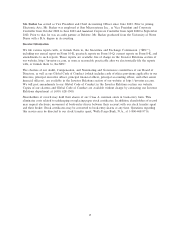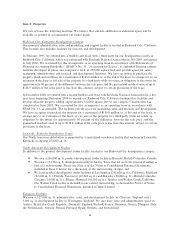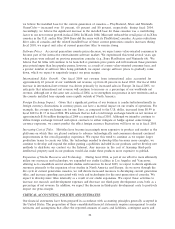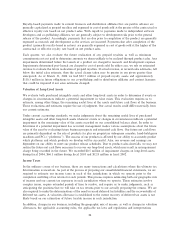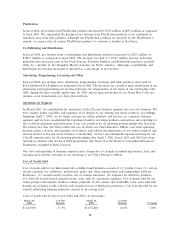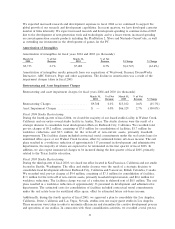Electronic Arts 2004 Annual Report Download - page 39
Download and view the complete annual report
Please find page 39 of the 2004 Electronic Arts annual report below. You can navigate through the pages in the report by either clicking on the pages listed below, or by using the keyword search tool below to find specific information within the annual report.Royalty-based payments made to content licensors and distribution aÇliates that are paid in advance are
generally capitalized as prepaid royalties and expensed to cost of goods sold at the greater of the contractual or
eÅective royalty rate based on net product sales. With regard to payments made to independent software
developers and co-publishing aÇliates, we are generally subject to development risk prior to the general
release of the product. Accordingly, payments that are due prior to completion of the product are generally
expensed as research and development as the services are incurred. Payments due after completion of the
product (primarily royalty-based in nature) are generally expensed as cost of goods sold at the higher of the
contractual or eÅective royalty rate based on net product sales.
Each quarter, we also evaluate the future realization of any prepaid royalties as well as minimum
commitments not yet paid to determine amounts we deem unlikely to be realized through product sales. Any
impairments determined before the launch of a product are charged to research and development expense.
Impairments determined post-launch are charged to cost of goods sold. In either case, we rely on estimated
revenue to evaluate the future realization of prepaid royalties. If actual revenue, or revised sales estimates, fall
below the initial sales estimate, then the actual charge taken may be greater in any given quarter than
anticipated. As of March 31, 2004 we had $22.7 million of prepaid royalty assets and approximately
$130.3 million in future obligations to our co-publishing and/or distribution aÇliates and content licensors
that could be impaired if our sales estimates changed.
Valuation of Long-Lived Assets
We evaluate both purchased intangible assets and other long-lived assets in order to determine if events or
changes in circumstances indicate a potential impairment in value exists. This evaluation requires us to
estimate, among other things, the remaining useful lives of the assets and future cash Öows of the business.
These evaluations and estimates require the use of judgment. Our actual results could diÅer materially from
our current estimates.
Under current accounting standards, we make judgments about the remaining useful lives of purchased
intangible assets and other long-lived assets whenever events or changes in circumstances indicate a potential
impairment in the remaining value of the assets recorded on our consolidated balance sheet. In order to
determine if a potential impairment has occurred, management makes various assumptions about the future
value of the asset by evaluating future business prospects and estimated cash Öows. Our future net cash Öows
are primarily dependent on the sale of products for play on proprietary videogame consoles, hand-held game
machines and PCs (""platforms''). The success of our products is aÅected by our ability to accurately predict
which platforms and which products we develop will be successful. Also, our revenue and earnings are
dependent on our ability to meet our product release schedules. Due to product sales shortfalls, we may not
realize the future net cash Öows necessary to recover our long-lived assets, which may result in an impairment
charge being recorded in the future. We recorded $0.5 million of impairment charges on long-lived assets
during Ñscal 2004, $66.3 million during Ñscal 2003 and $12.8 million in Ñscal 2002.
Income Taxes
In the ordinary course of our business, there are many transactions and calculations where the ultimate tax
determination is uncertain. As part of the process of preparing our consolidated Ñnancial statements, we are
required to estimate our income taxes in each of the jurisdictions in which we operate prior to the
completion and Ñling of tax returns for such periods. This process requires estimating both our geographic mix
of income and our current tax exposures in each jurisdiction where we operate. These estimates involve
complex issues, require extended periods of time to resolve, and require us to make judgments, such as
anticipating the positions that we will take on tax returns prior to our actually preparing the returns. We are
also required to make the determinations of the need to record deferred tax liabilities and the recoverability of
deferred tax assets. A valuation allowance is established to the extent recovery of deferred tax assets is not
likely based on our estimation of future taxable income in each jurisdiction.
In addition, changes in our business, including the geographic mix of income, as well as changes in valuation
allowances, the applicable accounting rules, the applicable tax laws and regulations and interpretations
24



